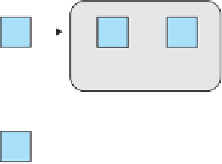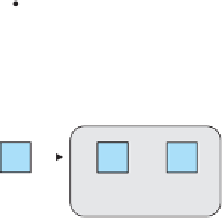Java Reference
In-Depth Information
After constructing the
Point
objects, we make the following method calls:
p1.translate(11, 6);
p2.translate(1, 7);
Essentially, the behavior of these two method calls is the following:
•
Set
this
to refer to the same object as
p1
, and execute the
translate
method
with parameters
(11, 6)
.
•
Set
this
to refer to the same object as
p2
, and execute the
translate
method
with parameters
(1, 7)
.
During the first call,
this
refers to the same object as
p1
. Therefore, the method
call adjusts the
(x, y)
coordinates of
p1
's object:
p1
x 3
x 18
y 8
p2
x 3
x 4
y 3
<methods>
<methods>
this
During the second method call
this
refers to the same object as
p2
, so the lines in
the body of the
translate
method change the
x
and
y
fields of
p2
's object:
p1
x 3
x 18
y 8
p2
x 3
x 5
y 10
<methods>
<methods>
this
One common usage of the keyword
this
is to deal with shadowed variables. As
described earlier, shadowing occurs when a field is obscured by another variable with
the same name. Shadowing can happen when a field has the same name as a para-
meter or local variable in a class. For example, the following is a legal header for our
Point
method, even though our fields are also called
x
and
y
:
public Point(int x, int y) {
As explained at the beginning of this section, Java would normally interpret the
expression
x
to mean
this.x
. However, if a parameter or local variable called
x
exists, the program will use that one instead if you just write
x,
because the field
x
is
shadowed by the parameter/variable. If you write
this.x
, though, the program will
always use the field
x
.









Search WWH ::

Custom Search